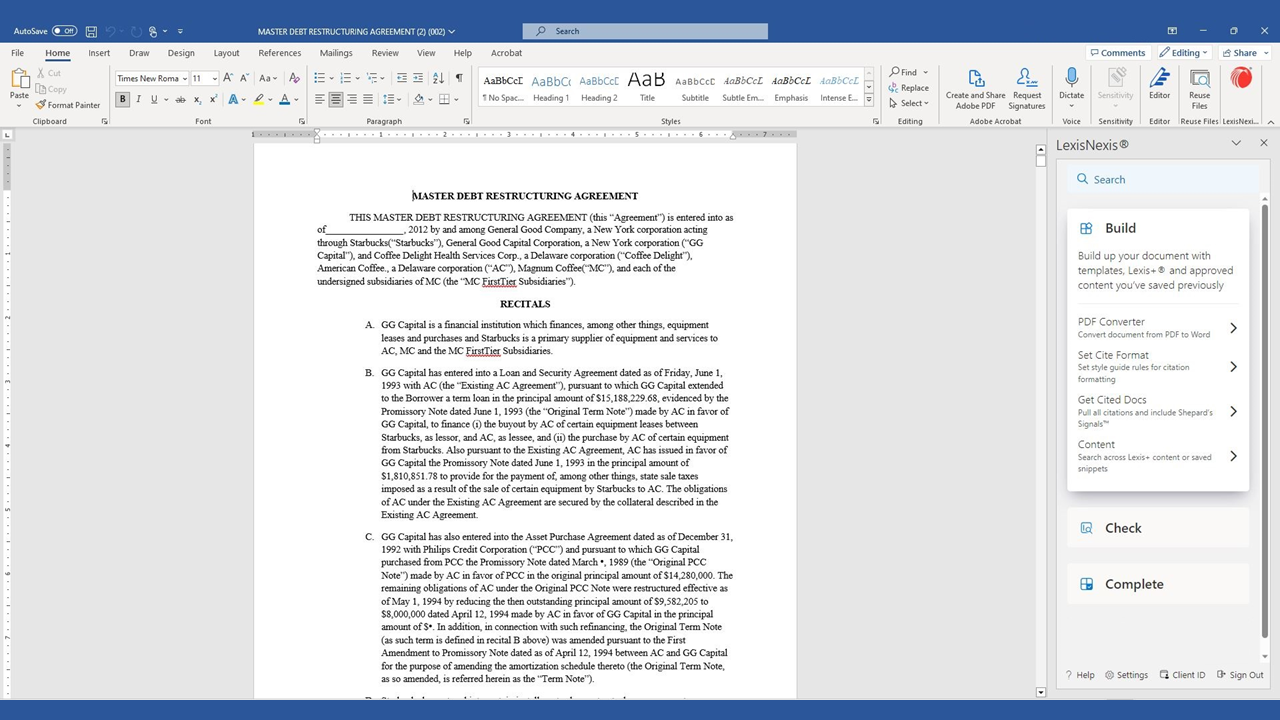LexisNexis is providing new details today on its collaboration with Microsoft to offer legal professionals AI-powered products and capabilities directly within the Microsoft 365 ecosystem that is typically the center of their workflows.
In a briefing yesterday, Jeff Pfeifer, chief product officer, Canada, UK and USA, at LexisNexis, revealed new information about the products being developed through the LexisNexis-Microsoft collaboration, all of which are focused on integrating generative AI capabilities into the legal product ecosystem that is centered in Microsoft products.
While some of today’s news builds on previous announcements, LexisNexis also announced new products coming down the pike. Specifically, the company announced four ways in which it is collaborating with Microsoft:
Lexis+ gets Azure OpenAI. In May, LexisNexis announced the launch of Lexis+ AI, a product that uses large language models (LLMs) to answer legal research questions, summarize legal issues, and generate drafts of documents such as demand letters or client emails. Now, LexisNexis is rolling out the Microsoft Azure OpenAI Service to customers of Lexis+.
“We are leveraging the OpenAI for Azure infrastructure to be able to support specific workflow tasks in research, some of which are already deployed,” Pfeifer told me. “Lexis+, for example, is now leveraging OpenAI for Azure infrastructure to power improved suggested searches to our clients.”
Lexis Connect gets launch date. In May, LexisNexis announced the preview launch of Lexis Connect, a legal intake and matter management product that works within Microsoft Teams and uses conversational AI assistants to help deliver answers more quickly. Now, the company says that Lexis Connect will be commercially available in the third quarter of this year, with generative AI capabilities added by year end.
Lexis Create launches in U.S. Released earlier this year in the UK, Lexis Create (pictured above) is today being officially released to the U.S. market. Lexis Create is an “intelligent” document drafting solution built into Microsoft Word. Within Word, users have direct access to LexisNexis content including Practical Guidance, Market Standards, Shepard’s Citations, AI-powered clause intelligence, and other tools. While the product is available now, extractive and generative AI enhancements will be added during the remainder of the year.
“The Create experience that exists today primarily focuses on proofreading capabilities, bringing Lexis+ content to the point of workflow, and a series of drafting enablers that assist the lawyer in drafting,” Pfeifer said. “But it does not yet currently have generative AI drafting capabilities in the solution. With what we’re announcing today, it will introduce those capabilities to Lexis Create and bring the drafting capabilities that you saw in the launch of Lexis+ AI back in May directly to the point of workflow activity in Word and Outlook.”
Lexis announces Create Plugin for Microsoft 365 Copilot. When Microsoft 365 Copilot launches next year, this plugin will bring LexisNexis legal data, citations and analytics into Copilot to be used with its generative AI functionality to draft, edit and validate documents within Microsoft Word.
“Copilot brings a set of additional guided task activity capabilities,” Pfeifer said, “so one could, for example, be instructed to look at additional information or be assigned workflow tasks that follow along a prescribed set of activities.”
For law firms and legal departments that want to take advantage of these new capabilities, Pfeifer emphasized that they will need Microsoft Office versions from 2019 or later, so firms that are planning upgrade schedules may want to take that into account. “Most of the benefits that are available from the newer generation of solutions, including generative AI and Copilot capabilities, all require later generations of Microsoft solutions,” Pfeifer said.
Pfeifer said that he believes it is important for LexisNexis to refine these products by providing preview access to customers. So, while they mostly will not be introduced commercially until later this year, LexisNexis is making them available selectively to customers on a preview basis so that they can suggest additional ways of developing or refining the products.
As I previously reported, one of those preview customers is Microsoft’s Corporate, External and Legal Affairs (CELA) department, which signed on as the first preview customer to test and help further develop Lexis Connect. Since then, several other legal departments have signed on as preview customers.
In customer testing so far of the Lexis+ AI product, Pfeifer said that he has seen greater involvement of more senior partners and decision makers that would be typical for a product rollout. “I think that’s reflective of general interest and understanding about what’s occurring in the space and what’s happening in the space,” he said.
He said that after LexisNexis announced its AI Insider program earlier this year, more than 1,000 firms signed up the first week and more than 8,000 have joined to date.
“A major purpose of this announcement between LexisNexis and Microsoft is to confirm the collaboration in this development along a specific set of target dates so that customers can understand, if they’re making decisions to upgrade basic things like Office or other product elements within their infrastructure, that they’ll see a well-developed ecosystem of capabilities from LexisNexis that are designed to align with the investments that they’re making more broadly in Microsoft products,” Pfeifer said.
 Robert Ambrogi Blog
Robert Ambrogi Blog